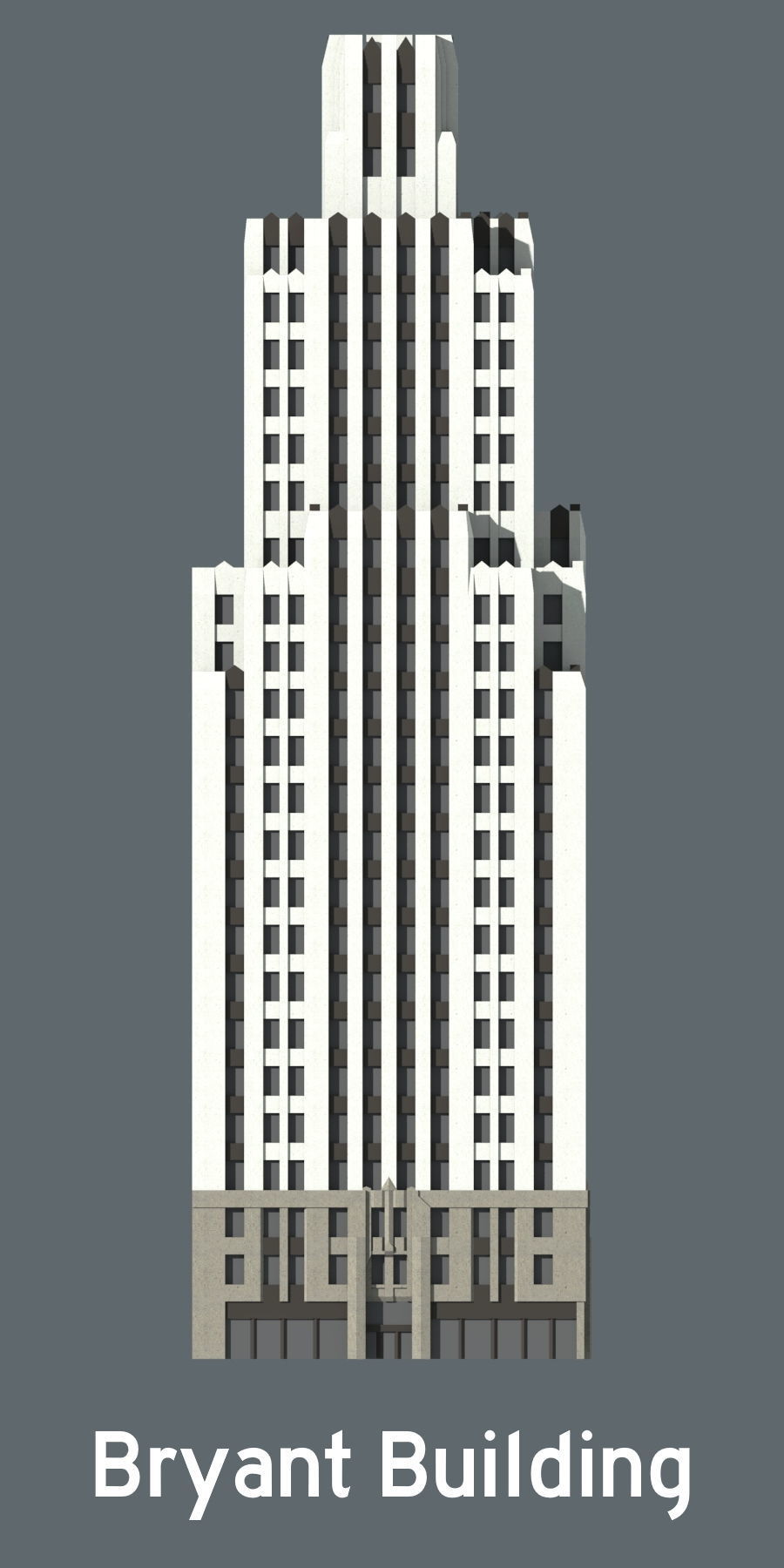
Historic Kansas City Pack 3D print model
Located near the very center of the continental United States, Kansas City is the largest city in Missouri. Founded close to Missouri’s Western border with Kansas, the city sits above the confluence of the Kansas and Missouri Rivers. As Kansas City grew rapidly throughout the late 19th and early 20th centuries, the metropolis came to boast an impressive collection of pre-war buildings scattered through its historic downtown core. Many of the largest and most famous buildings were built amidst the boom and bust of the 1920s and 30s, when the city was under the control of Tom Pendergast and the corrupt political machine he created. This collection contains models of 6 famous Kansas City skyscrapers named and described below in the order they appear in the images.
The Kansas City Power & Light Building is a 481ft (147m) tall skyscraper on the Southern end of the city’s downtown loop. Designed for its namesake energy company by architecture firm Hoit, Price & Barnes, the building was completed in 1931. The building stood as the tallest building in both the city and state. It was also the tallest building in the United States constructed West of the Mississippi River.Its classic art deco design and magnificent illuminated crown make it a cherished landmark of the city. While the Kansas City Power & Light Company has since gone out of business, the building's original name has remained and has come to lend its name to the Power & Light District, the surrounding area that features cultural attractions to revitalize downtown Kansas City.In the decades since the tower's opening, its offices have been vacated and the building has been converted to residential use.
909 Walnut is a 471ft (144m) tall highrise designed by Hoit, Price & Barnes and finished in 1931. Upon its completion, 909 Walnut was the 2nd tallest building in the city and the state of Missouri for 45 years. The tower's unique twin spires and fusion of Art Deco and Gothic Revival architecture make it a Kansas City landmark.Originally named the Fidelity National Bank & Trust Building, its namesake bank went under soon after construction of the building due to the Great Depression. From there, it was purchased and used by the US federal government. In recent years, the building has been repurposed for residential use. During its conversion, the clock that once adorned the Northern spire was removed. This model recreates the building as it was originally designed with its clock faces.
The Oak Tower, also known as the Bell Telephone Building, was designed by Hoit, Price & Barnes in collaboration with I.R. Timlin in a Gothic-Revival style. Originally constructed in 1913 at a height of 185ft (56m), the building was later doubled in height in 1929. At its final height of 379ft (116m), it briefly held the title of Kansas City and the state of Missouri's tallest building until eclipsed by 909 Walnut and the Power & Light Building.In 1974, when the building was sold to new owners, its magnificent gothic ornamentation was buried beneath stucco. While today the tower's historic facade remains hidden, this model aims to recreate the original design in its full beauty.
The Bryant Building is 318ft (97m) tall and built in 1930. Designed by Chicago-based architecture firm Graham Anderson Probst and White, the building is a sleek example of Art Deco architecture. Its multi-color terra cotta and metal paneling is arranged in a way to, in conjunction with characteristic setbacks, accentuate the vertical elements of the building. For a brief period upon its completion, it was the 2nd tallest building in the city. Today, it functions as a data center.
City Hall is an art deco skyscraper standing 433ft (135m) tall. A flagpole atop the building, while not counted towards the building’s official height, tops out at 525ft (160m) high. The massive building houses the city’s administrative offices and ranks among the world’s tallest municipal buildings. Constructed in 1937, it used funds from the Public Works Administration, an agency established as part of President FDR’s New Deal program. Much of this money ended up in the pockets of contractors closely involved with Pendergast’s patronage network. The architects, Wight & Wight, designed the building in a style that combines an austere neoclassical and art deco that make heavy use of bas-relief artwork in its facade common throughout Depression era projects.
The Jackson County Courthouse stands directly South of City Hall across 12th St, creating a large public space around Kansas City’s greatest monuments to civic service. Also designed by Wight & Wight, its similar design makes it a shorter architectural companion to City Hall. The design of the building was guided by then future-president Harry S. Truman, who was the presiding judge of Jackson County. The 295ft (90m) tall building, completed in 1934, was also constructed as part of the New Deal’s public works programs.
NOTES:
- The Kansas City Power & Light Building, 909 Walnut, Oak Tower, and City Hall are all available for purchase individually
- Models were designed for the sole purpose of 3D Printing. However, included are .zip folders that contain the models in other formats with very basic materials as seen in the above images for use in other 3D modeling software.
- Background Image on Preview Slide is sourced from the Internet Archive Book and is public domain




















